5 books about Metallurgy
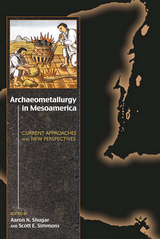
Archaeometallurgy in Mesoamerica
Current Approaches and New Perspectives
Aaron N. Shugar
University Press of Colorado, 2013
Presenting the latest in archaeometallurgical research in a Mesoamerican context, Archaeometallurgy in Mesoamerica brings together up-to-date research from the most notable scholars in the field. These contributors analyze data from a variety of sites, examining current approaches to the study of archaeometallurgy in the region as well as new perspectives on the significance metallurgy and metal objects had in the lives of its ancient peoples.
The chapters are organized following the cyclical nature of metals--beginning with extracting and mining ore, moving to smelting and casting of finished objects, and ending with recycling and deterioration back to the original state once the object is no longer in use. Data obtained from archaeological investigations, ethnohistoric sources, ethnographic studies, along with materials science analyses, are brought to bear on questions related to the integration of metallurgy into local and regional economies, the sacred connotations of copper objects, metallurgy as specialized crafting, and the nature of mining, alloy technology, and metal fabrication.
The chapters are organized following the cyclical nature of metals--beginning with extracting and mining ore, moving to smelting and casting of finished objects, and ending with recycling and deterioration back to the original state once the object is no longer in use. Data obtained from archaeological investigations, ethnohistoric sources, ethnographic studies, along with materials science analyses, are brought to bear on questions related to the integration of metallurgy into local and regional economies, the sacred connotations of copper objects, metallurgy as specialized crafting, and the nature of mining, alloy technology, and metal fabrication.
[more]
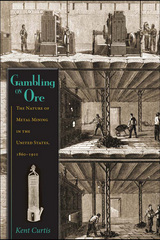
Gambling on Ore
The Nature of Metal Mining in the United States, 1860–1910
Kent Curtis
University Press of Colorado, 2013
Gambling on Ore examines the development of the western mining industry from the tumultuous and violent Gold Rush to the elevation of large-scale copper mining in the early twentieth century, using Montana as representative of mining developments in the broader US mining west. Employing abundant new historical evidence in key primary and secondary sources, Curtis tells the story of the inescapable relationship of mining to nature in the modern world as the United States moved from a primarily agricultural society to a mining nation in the second half of the nineteenth century.
In Montana, legal issues and politics—such as unexpected consequences of federal mining law and the electrification of the United States—further complicated the mining industry’s already complex relationship to geology, while government policy, legal frameworks, dominant understandings of nature, and the exigencies of profit and production drove the industry in momentous and surprising directions. Despite its many uncertainties, mining became an important part of American culture and daily life.
Gambling on Ore unpacks the tangled relationships between mining and the natural world that gave material possibility to the age of electricity. Metal mining has had a profound influence on the human ecology and the social relationships of North America through the twentieth century and throughout the world after World War II. Understanding how we forged these relationships is central to understanding the environmental history of the United States after 1850.
In Montana, legal issues and politics—such as unexpected consequences of federal mining law and the electrification of the United States—further complicated the mining industry’s already complex relationship to geology, while government policy, legal frameworks, dominant understandings of nature, and the exigencies of profit and production drove the industry in momentous and surprising directions. Despite its many uncertainties, mining became an important part of American culture and daily life.
Gambling on Ore unpacks the tangled relationships between mining and the natural world that gave material possibility to the age of electricity. Metal mining has had a profound influence on the human ecology and the social relationships of North America through the twentieth century and throughout the world after World War II. Understanding how we forged these relationships is central to understanding the environmental history of the United States after 1850.
[more]
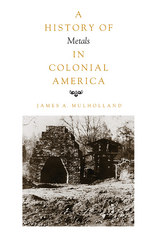
History of Metals in Colonial America
James A. Mulholland
University of Alabama Press, 1981
The story of the introduction and growth of the technology of metals in the North American colonial period entails significant developments beyond the transfer of the technology from the Old World to the New. In the struggle to create an indigenous industry, in the efforts to encourage and support the work of metals craftsmen, in the defiance of British attempts to regulate manufacturing of metals, the colonial society developed a metals technology that became the basis for future industrial growth.
The author traces colonial industrial development from the sixteenth through the eighteenth centuries in nine chapters: “Before Jamestown,” “Metals in the Early Colonies,” “Copper in the Colonies,” “Colonial Iron: The Birth of an Industry,” “Metals Manufacture in the Colonial Period,” “Colonial Iron: Regulation and Rebellion,” “Metals and the Revolution,” “The Critical Years,” and “Reflections on the End of an Era.”
[more]
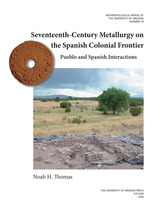
Seventeenth-Century Metallurgy on the Spanish Colonial Frontier
Pueblo and Spanish Interactions
Noah H. Thomas
University of Arizona Press, 2018
A unique contribution to the archaeological literature on the Southwest, Seventeenth-Century Metallurgy on the Spanish Colonial Frontier introduces a wealth of data from one of the few known colonial metal production sites in the Southwest. Archaeologist Noah H. Thomas draws on and summarizes ten seasons of excavation from the Pueblo of Paa-ko to provide a critical analysis of archaeological features and materials related to metal production during the early colonial period (AD 1598–1680). Extrapolating from the data, Thomas provides a theoretical interpretation of these data that is grounded in theories of agency, practice, and notions of value shaped in culture. In addition to the critical analysis of archaeological features and materials, this work brings to light a little-known aspect of the colonial experience: the production of metal by indigenous Pueblo people.
Using the ethnography of Pueblo peoples and seventh-century European manuals of metallurgy, Thomas addresses how the situated agency of indigenous practitioners incorporated within colonial industries shaped the metallurgy industry in the Spanish colonial period. The resulting analysis investigates how economic, technical, and social knowledge was communicated, contested, and transformed across the social and cultural boundaries present in early colonial communities. Viewing these transformations through an ethnohistorical lens, Thomas builds a social and historical context within which to understand the decisions made by colonial actors at the time.
Using the ethnography of Pueblo peoples and seventh-century European manuals of metallurgy, Thomas addresses how the situated agency of indigenous practitioners incorporated within colonial industries shaped the metallurgy industry in the Spanish colonial period. The resulting analysis investigates how economic, technical, and social knowledge was communicated, contested, and transformed across the social and cultural boundaries present in early colonial communities. Viewing these transformations through an ethnohistorical lens, Thomas builds a social and historical context within which to understand the decisions made by colonial actors at the time.
[more]
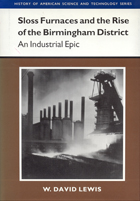
Sloss Furnaces and the Rise of the Birmingham District
An Industrial Epic
W. David Lewis
University of Alabama Press, 1994
This pathbreaking book tells the dramatic story of a unique manufacturing complex and the city that it helped to create. The events recounted and interpreted by W. David Lewis are of more than local or regional significance. The rise of Sloss furnaces and Birmingham epitomized the emergence of the United States as the world's foremost economic power. Similarly, the closing of a once-profitable ironmaking installation amid social and technological changes that convulsed Birmingham nine decades after the city's founding typified challenges that were facing America at the dawn of the postindustrial age.
Above all, Sloss Furnaces resonates with the class of competition and the frenetic energy with which southerners joined other Americans in a rush to transform a continent after a fratricidal drive for independence had failed. The sweeping narrative that Lewis has produced amply justifies its subtitle, An Industrial Epic.
[more]
READERS
Browse our collection.
PUBLISHERS
See BiblioVault's publisher services.
STUDENT SERVICES
Files for college accessibility offices.
UChicago Accessibility Resources
home | accessibility | search | about | contact us
BiblioVault ® 2001 - 2024
The University of Chicago Press









